How to Texture Paint a Wall for a Cozy Living Room Look
Disclosure: This post contains affiliate links. If you purchase them, I may earn a small commission at no additional cost to you. Thanks for supporting the blog!
Do you want to make your living room feel warm and inviting? One simple way to do that is by adding texture to your walls. In this blog post, you’ll learn how to texture paint a wall step by step. We’ll also help you choose natural colors and cozy lighting to complete the look. Textured walls add depth and character to any space, making it feel more stylish and comfortable. Even small changes like this can make a big difference in how your living room looks and feels. Whether you’re updating an old wall or starting fresh, this guide will make the process easy and fun.
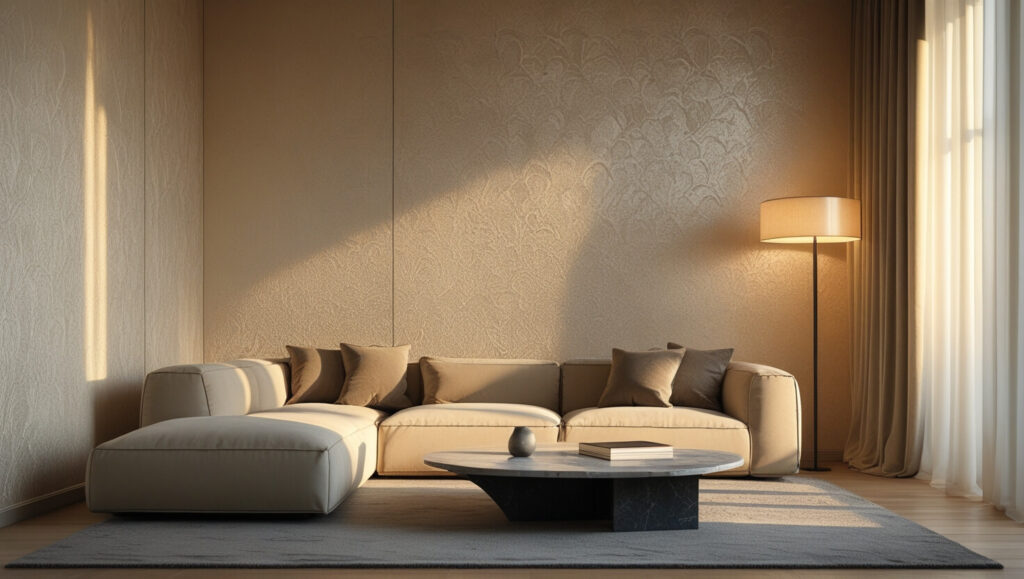
Why Choose Texture Painting for Your Living Room?
Texture painting adds a special touch to plain walls. It gives your space depth, warmth, and style—perfect for cozy living rooms. Instead of flat, boring walls, you get a more interesting and welcoming look that feels just right for relaxing or spending time with family.
Here are some reasons to try it:
Makes your room feel warm and lived-in
Textured walls make the space feel more inviting and comfortable, like a place where people want to sit and stay a while.Adds a soft, natural look
It creates a gentle, natural finish that blends well with wood furniture, plants, and earthy decor.Works well with warm lights and neutral colors
The texture catches light in a beautiful way, making soft lighting and natural colors look even better.Easy to do yourself at home
You don’t need to hire a professional. With the right tools and a little time, you can do texture painting yourself and save money.Hides small wall flaws
If your walls have tiny cracks or marks, texture paint can help cover them up and make everything look smooth and neat.Gives your space a unique style
No two textured walls are exactly the same, so your living room will feel one-of-a-kind and full of personality.
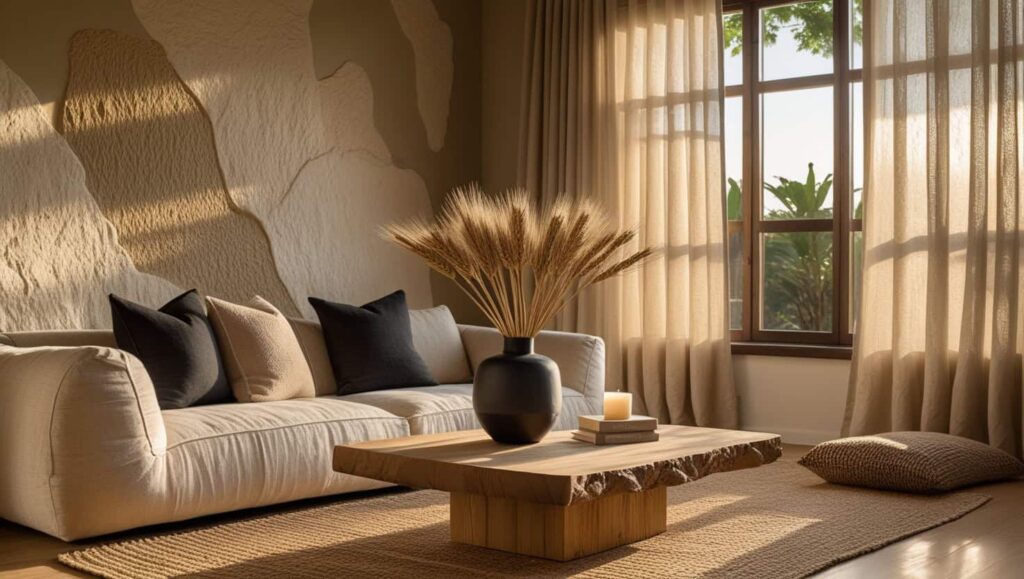
Tools and Materials You’ll Need
Before you begin your texture painting project, it’s important to gather all the right tools and materials. Having everything ready will make the process smoother and help you get professional-looking results.
Here’s what you’ll need:
Texture paint or joint compound
This is the main material that creates the textured effect on your wall.Putty knife or trowel
Use these tools to apply and shape the texture. They help spread the material evenly.Sponge or roller (for patterns)
A sponge or texture roller can add beautiful patterns and designs to your wall, depending on the look you want.Primer
Applying a primer before texture paint helps the material stick better and last longer.Drop cloths or plastic sheets
These protect your floors and furniture from paint splatters and mess.Painter’s tape
Use this to cover edges, trims, or areas you don’t want to paint.Natural color paint (like beige, sage, or soft gray)
Once the texture is dry, apply a coat of natural-colored paint to create a warm, calming look that suits cozy living rooms well.
Tip: Choose low-VOC or eco-friendly paints to create a healthier environment for your home. These paints release fewer harmful chemicals and are better for both your health and the planet.
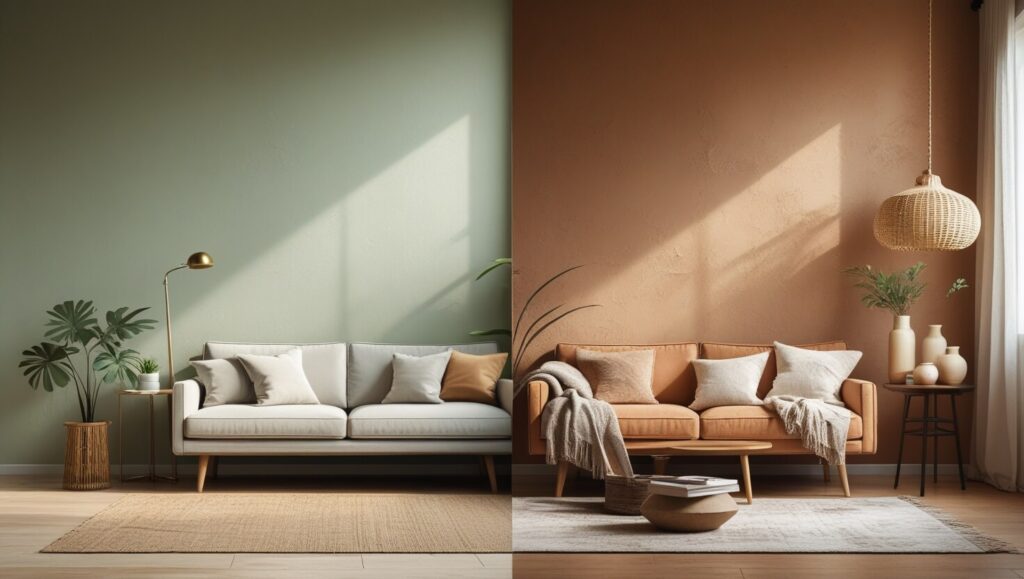
Step-by-Step: How to Texture Paint a Wall
Texture painting may look tricky, but it’s actually easy when you follow the right steps. Here’s a simple guide to help you get smooth, stylish results:
1. Prepare the Wall
Start with a clean, ready surface.
Wipe the wall with a damp cloth to remove any dust, dirt, or grease.
Check for cracks or holes and fill them with putty if needed.
Use painter’s tape to protect corners, edges, switches, and trim.
Cover the floor and nearby furniture with drop cloths or plastic sheets to keep them safe from paint splashes.
Taking time to prepare the wall properly will help your texture stick better and last longer.
2. Apply Primer
Priming is an important step that should not be skipped.
Use a paint roller to apply a coat of primer evenly across the wall.
Allow it to dry completely, which usually takes a few hours.
Primer helps the texture bond to the wall and gives you a more even finish.
3. Add the Texture
Now it’s time to apply the fun part—your texture!
Use a putty knife or trowel to spread the texture paint or joint compound over the wall.
Apply it in small sections to give yourself time to shape the pattern before it dries.
Try out different texture styles based on your taste:
Sponge Texture: Dab a clean sponge onto the wet surface to create a soft, natural effect.
Knockdown Texture: Apply the compound, let it set for a few minutes, then lightly smooth the peaks with a trowel.
Combed Texture: Use a notched trowel or comb to create neat, stylish lines or patterns.
Take your time and be creative. Each wall will look unique!
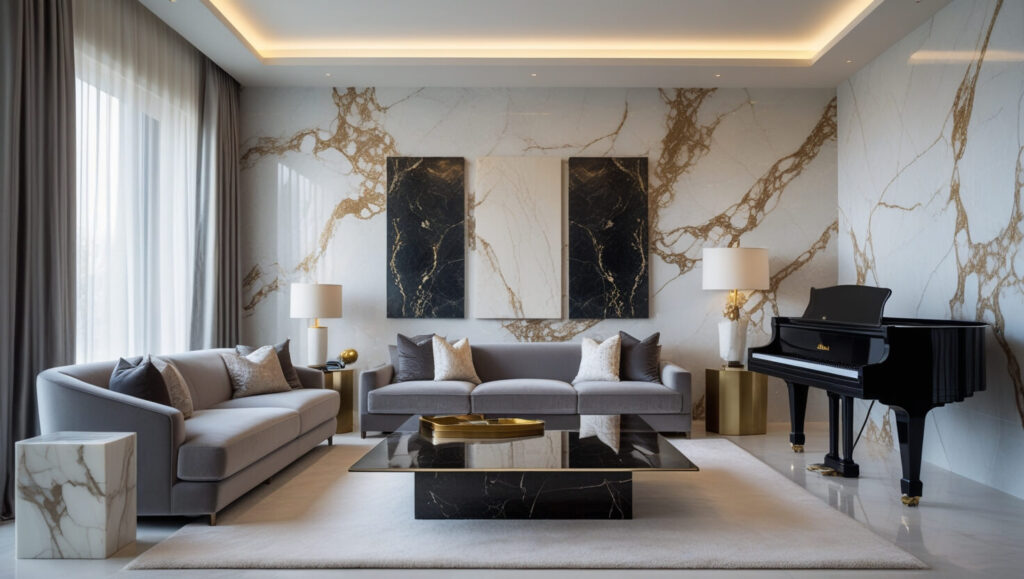
4. Let It Dry
This step is all about patience.
Let the textured wall dry completely, which can take 24 to 48 hours, depending on the thickness and room temperature.
Avoid touching or painting it before it’s fully dry to keep the texture clean and sharp.
5. Paint Over the Texture
Now, bring your textured wall to life with color.
Choose a soft, natural paint color that fits your cozy living room style. Good options include:
Clay beige
Warm white
Dusty pink
Sage green
Terracotta
Use a roller for larger areas to cover quickly and smoothly.
Use a brush for edges, corners, and around trim for neat results.
For the best finish, apply two thin coats of paint, letting the first coat dry before starting the second.
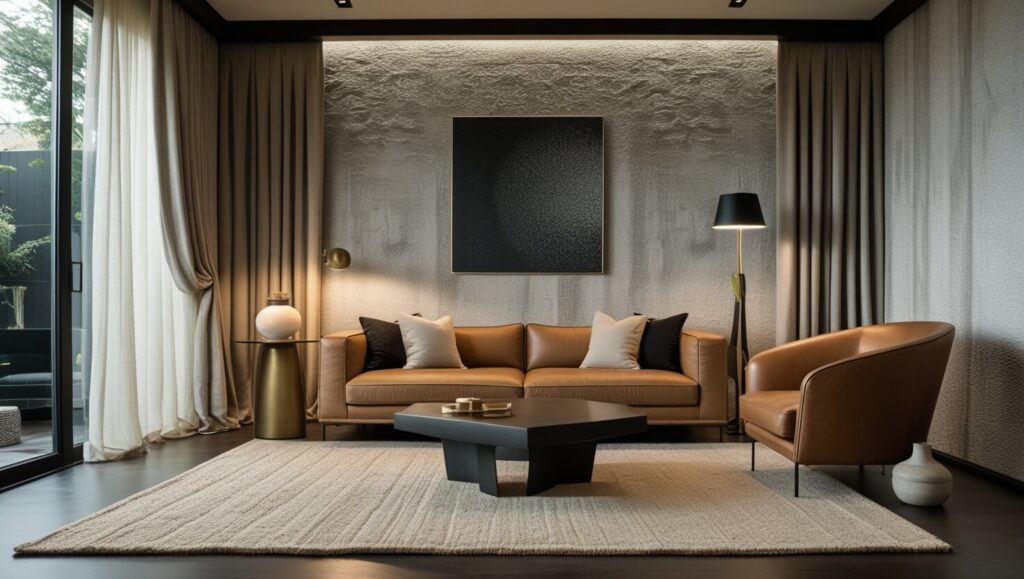
Best Natural Colors for a Cozy Wall Look
Choosing the right paint color is just as important as adding texture. Natural shades create a calm, welcoming feel, perfect for a cozy living room where you can relax and unwind.
Here are some beautiful and popular options to consider:
Warm white – A clean, soft shade that brightens the space without feeling too sharp.
Beige or taupe – Classic and neutral, these tones bring warmth without being too bold.
Sage green – A gentle, earthy color that adds a peaceful, natural touch.
Terracotta – Rich and warm, this shade adds depth and a cozy, grounded feel.
Dusty rose – Soft and romantic, perfect for creating a relaxed and stylish atmosphere.
👉 Need help choosing the perfect beige tone? Check out our top beige paint picks for small living rooms.
These colors work wonderfully with wooden furniture, lightweight curtains, and soft rugs to complete the cozy look. You can also add warm lighting and natural textures like rattan or cotton to enhance the relaxing vibe of your living room.
Add Warm Lighting to Highlight the Texture
Textured walls truly come to life when paired with the right lighting. Good lighting doesn’t just brighten the room—it enhances the depth and detail of the texture, making your wall a beautiful focal point.
Here’s how to highlight your texture with warm, cozy lighting:
Use warm light bulbs (2700K–3000K) to create a soft, welcoming glow instead of harsh white light.
Add floor lamps, table lamps, or wall sconces to cast gentle shadows that highlight the texture and create a relaxing mood.
Let in plenty of natural light during the day by using sheer curtains or leaving windows uncovered when possible.
Lighting makes a big difference—it brings out the patterns, adds warmth to the room, and gives your wall a cozy, professional finish.
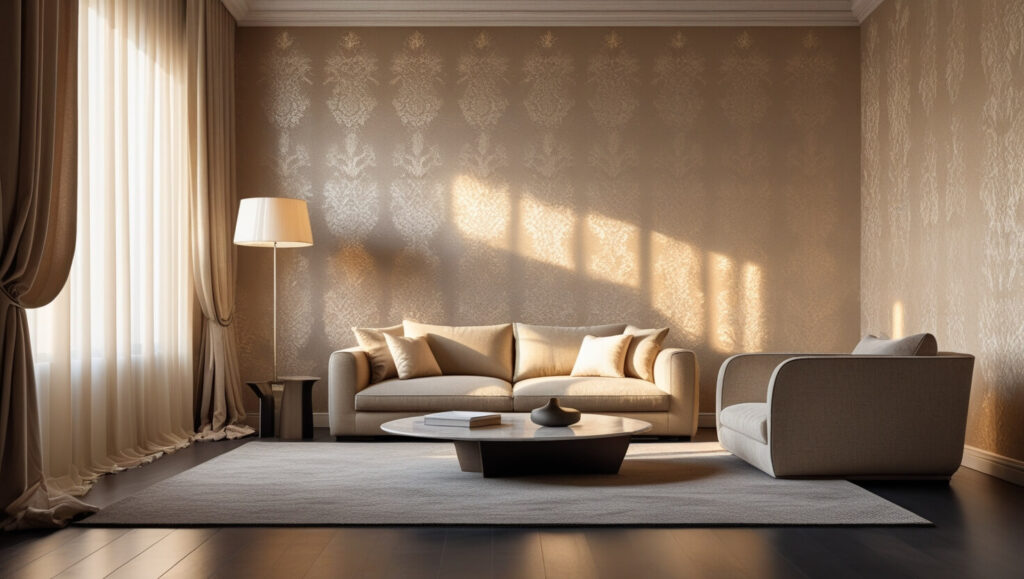
Easy Styling Ideas After Painting
Now that your wall is beautifully textured and painted, keep your decor simple and cozy so the wall remains the star of the space.
Here are some easy styling tips:
Use wooden picture frames or floating shelves to add charm without cluttering the wall.
Choose throw pillows and blankets in soft, earthy tones that match your wall color.
Add natural textures like cotton curtains and cozy rugs to complete the warm look.
Stick to a neutral color palette to keep the overall vibe calm and inviting.
A textured wall adds character all on its own, so you don’t need to overdecorate.
👉 Looking for more design inspiration? Explore the top interior design trends for a modern home makeover in 2025.
These trends can help you take your living room style even further, blending cozy charm with modern elegance.
Recommended Products to Try
To help you start your textured wall project with ease, here are some trusted products that are easy to use and perfect for cozy living rooms.
1. Eco-Friendly Texture Paint
Rust-Oleum Wall Texture Paint – Low VOC, Sand Finish
Great for adding subtle texture while keeping the air clean. It’s easy to apply with a roller or brush.
2. Natural Wall Paint
BEHR Premium Plus Interior Paint in “Wheat Bread” (Beige)
A warm, neutral beige is perfect for small and cozy spaces.Sherwin-Williams “Clary Sage” Green
A soft, earthy sage green that works beautifully with wooden furniture.
3. Warm Light Floor Lamps
Adesso Oslo Floor Lamp with Warm White LED Bulb
Simple and stylish, this lamp adds a cozy, warm glow that enhances wall textures.
4. DIY Painting Tool Kit
Bates Painting Kit—11-Piece Set
Includes everything you need—roller, brushes, tray, and drop cloths. Great for beginners.
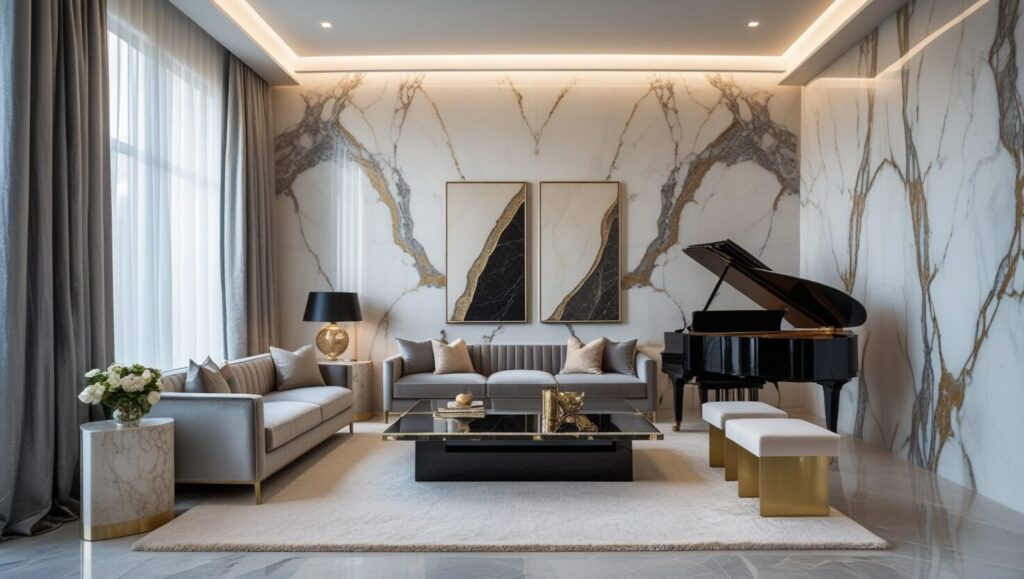
FAQs: How to Texture Paint a Wall
Q: Can I texture paint over an old painted wall?
A: Yes, you can apply texture over an already painted wall. Just make sure the surface is clean, dry, and smooth. It’s important to wipe off dust and grease, then apply a quality primer so the texture adheres properly and lasts longer.
Q: How long does textured paint take to dry?
A: Textured paint usually takes 24 to 48 hours to fully dry, depending on the thickness and humidity. Be patient and avoid touching or painting over it too soon—this will help the finish stay clean and even.
Q: What’s the easiest texture for beginners?
A: The sponge technique is one of the easiest methods for beginners. It’s simple to apply and forgiving if you make a mistake. It creates a soft, natural pattern that’s great for cozy living room walls.
Q: Do I need to seal the textured wall with anything?
A: Not always, but if you want extra durability—especially in high-traffic areas—you can add a clear matte sealant over the paint. This helps protect the wall and makes cleaning easier.
Q: Can I texture just one wall instead of the whole room?
A: Absolutely! A single accent wall with texture can make a big impact without overwhelming the space. It’s a great way to add character while keeping the rest of the room simple and light.
Conclusion
Now you know how to texture paint a wall and create a cozy, stylish living room using natural colors and warm lighting. This simple DIY project can completely transform the mood of your space, making it feel more welcoming, comfortable, and lived-in.
Texture painting doesn’t require perfection—it’s all about adding personality and charm to your walls. Whether you go for a soft sponge look or a bold knockdown style, the results will reflect your unique style and creativity.
Don’t be afraid to try it—just start small, take your time, and enjoy the process. You’ll be surprised how much character a textured wall can bring to your living room.
Ready to give your wall a cozy makeover? Save this post, gather your tools, and start your DIY project this weekend. Your perfect, warm living space is just a few brushstrokes away!

Pingback: Frame Wall Art Flower Ideas: 17 Best Designs for 2024 - stylishhomelook.com
Pingback: Cozy Living Room Ideas: 10 Ways to Create a Space You'll Love - stylishhomelook.com